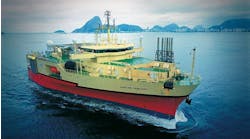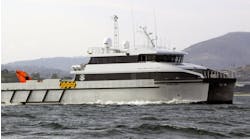Albena Mateeva, Javier Ferrandis, Andrey Bakulin, Patsy Jorgensen, Carol Gentry, Jorge Lopez - Shell
Using walk-away or 3D vertical seismic profile (VSP) data to create virtual sources (VS) in salt is a new, useful tool for imaging and assessing drilling hazards in salt and immediately below the base of salt.
The new virtual source applications can have significant business impact for minimizing drilling risk through salt and improving well targeting in areas with salt. The application also can be used to accurately position steep salt flanks.
Creating virtual sources inside homogeneous salt allows distorting effects caused by rugged top salt and complex overburden to be eliminated. The virtual source radiation pattern can be controlled and steered in the direction of desired illumination by selecting appropriate shot ranges at the surface.
The virtual source method turns VSP receivers into downhole “sources” to help “see” under complex overburden where other seismic methods have difficulties. A typical example of problematic overburden is rugged salt. Creating virtual sources from VSP data underneath salt can help image subsalt targets with unprecedented clarity.
Ideally, such images would be based on receivers below salt. However, even if the virtual source receivers are in salt (VSPs often are acquired to look ahead in preparation for exiting salt), virtual source offers benefits.
For example, subsalt sediments can be imaged more clearly with virtual source than with surface sources because with virtual source, issues related to rough top salt become irrelevant. In addition, virtual sources in salt allow examination of potential drilling hazards such as inclusions in salt and pore pressure anomalies below salt. Virtual source also more accurately defines the salt base/flanks.
Cost benefits can be substantial, particularly in the Gulf of Mexico, where each drilling incident or sidetrack can cost $5-10 million.
Creating a virtual source
While many formal derivations of the virtual source method have appeared, for the geophysical practitioner, the following logic captures the essence of the method.
Steering virtual sources for salt and subsalt imaging.
Walk-away or 3D VSP data are used to create a VS at every receiver. From a processing standpoint, it suffices to visualize the technique as a cross-correlation of direct-arrival energy at one buried geophone (the “virtual source”) with the trace recorded at a second geophone (the receiver).
The result, once summed over a suitable set of illuminating physical sources, approximates the response of a buried source-receiver pair in the subsurface. This data-driven virtual source redatuming does not require velocity information. This is the crucial factor in creating VS data in a complex medium.
To image targets with this virtual source data, the velocity between the receivers and the target must be known. This is a much weaker requirement than knowing the entire velocity model to the surface, which is required for conventional imaging with surface sources.
In the case of receivers in salt, imaging the salt flanks or inclusions in salt is easy because only the salt velocity is needed. This value is relatively constant and is readily measurable, for example, from virtual checkshots.
Example 1: Look-ahead VSP with VS for in-salt hazard and salt-exit prediction.
While a well was being drilled through thick salt in the GoM, a walk-away VSP was acquired about 4,000 ft (1,219 m) above the expected base of salt. Surface seismic showed these potential troubles on the path ahead:
- A small bright in-salt event of uncertain nature (artifact? hazard?) about half way to the base of salt
- A complex base of salt interface with a potential for highly over-pressured sands immediately below.
Virtual source was used to obtain a high-resolution image of the path ahead. The VSP dataset consisted of 40 geophones at 50-ft (15-m) spacing. The geophones were transformed into 40 virtual sources, giving a total of 1,600 source-receiver pairs illuminating a narrow path ahead of the well.
Summary of predictions based on virtual source data (red) versus actual well findings (green).
The high-fold dataset confirmed that the prominent seismic feature in the salt was an intra-salt reflection, not a multiple from the surface seismic. Study of the virtual source gathers allowed geologists to estimate the dip, time, and seismic nature (hard) of the intra-salt reflector. A salt velocity estimate from the corresponding virtual check shot yielded a prediction to the depth of the reflector 2,000 ft (610 m) ahead of the well with 50 ft (15 m) uncertainty; the prediction was communicated to the rig, which encountered the inclusion within 2 ft (0.6 m) of the prognosis.
A similar analysis yielded a prediction for the depth to base of salt 4,000 ft (1,219 m) ahead of the well with 70 ft (21 m) uncertainty. This prediction was also validated by the well results. Further dissection of the base salt reflection on the VS data revealed a bright event 350 ft (107 m) below salt, suggestive of hydrocarbons, which drilling validated as well.
To make these predictions, it was useful to steer the VS radiation pattern by using only subsets of all available VSP sources to create VS data. For example, if only VSP sources to the left of the well are used to “feed” the VS, the resulting VS radiates mainly (down and) to the right, and correspondingly, illuminates only reflectors dipping to the left. Such decomposition of the VS images is a helpful interpretation tool, even it is best to use the virtual source image obtained from all virtual source sources though for quantitative purposes (e.g., picking the time of a reflector) because it is best focused.
Helpful insights into the nature of seismic events can be gained by combining P and S wave information. SS reflections from the in-salt inclusion were obtained by harvesting PS conversions in the VSP data to create virtual shear sources in the salt. Combining virtual PP and SS reflections from subsalt interfaces can give an estimate of Vp/Vs source below salt, which, in turn, can be used for pore pressure prediction immediately below salt. This is a promising virtual source application even though it does not address existing uncertainties in translating Vp/Vs to pore pressure.
In principle, the virtual source data created for in-salt hazard characterization can be used to image the sediments below salt. However, the acquisition geometry in this case - a short receiver string in a vertical well - is not optimal for subsalt illumination. It gives a narrow, almost one dimensional, image of mildly dipping subsalt sediments. To get a wider image, a sidetrack is needed in the salt that is deviated along the direction of expected subsalt dips. The angle between the instrumented well and the target reflector is the crucial factor controlling the virtual source image size. Virtual sources in vertical wells are best suited for steep target illumination, such as the salt flank.
Example 2: Salt flank positioning with VS
In The Netherlands, Shell is assisting Akzo Nobel to evacuate salt caverns for underground gas storage. The caverns will be 300 m (984 ft) high and have 60 m (197 ft) diameter, starting at 1 km (0.6 mi) depth and must not be less than 100 m (328 ft) from the salt flank.
The Zuidwending salt dome is an upward lobe of the Zechstein salt formation, which tightly seals the huge Groningen gas field underneath. The geometry of the salt dome has been derived from surface seismic, but it remains rather uncertain (± 200 m or 656 ft) along the vertical flanks. A salt proximity survey would require very distant sources to image a useful portion of the salt flank and would be very uncertain. On the other hand, generating virtual sources in the salt, can accurately estimate the lateral position of the salt flank based on salt velocity.
Planned salt caverns for underground gas storage in The Netherlands. Uncertainty of lateral positioning of salt flank from surface seismic needs to be reduced for safe placement of salt cavern.
A conventional walk-away VSP with receivers in the salt cavern pilot holes would suffice to create the necessary virtual sources. A 30-level 3C receiver tool with 15-m (49-ft) spacing is a given (due to operation logistics). For optimal shot placement, pre-survey modeling is important.
Shot locations initially were chosen based on ray tracing. Then, a long line of shots approximately centered at those locations generated full-waveform VSP synthetic data (2D elastic with a free surface) to study shot range and shot spacing effects on virtual source data. Some 60 VSP shots at 50-m (164-ft) spacing were sufficient to create high-quality virtual source data for salt flank imaging.
The salt flank reflection is much easier to see on the virtual source data than on the VSP. On the VSP data, it is swamped by PS conversions and top-salt multiples. It would be difficult to extract by conventional VSP processing, and most importantly, the position of the salt flank on a virtual source image would depend on the entire overburden velocity model, including sediments and the rather uncertain point of salt entry. The salt reflection clearly stands out on the virtual source data created from the horizontal (inline) receiver component of the VSP.
Picking the reflection time on the zero-offset virtual source gather (simplest), the model interface reproduced with better than 25-m (82-ft) precision, which was sufficient to justify acquisition. Acquisition will include three walk-away virtual source lines with slightly different azimuths to accommodate the existing uncertainty in the salt flank strike.
In total, there will be 180 shots - more acquisition effort than in a classical salt prox but with much better prognosis for success.
Acknowledgements
We thank Shell International Exploration & Production Inc. for permission to publish this paper and Akzo Nobel and Plains Exploration for permission to show the datasets.






